[A] : Every biological system resists a change and wants to remain in a state of equilibrium .
[R] : Climax communities of an ecosystem are produced after several changes it has gone through succession .
If both A and R are true and R is the correct explanation of A
If both A and R are true but R is not the correct explanation of A
If A is true and R is false
If both A and R are false
Step-by-Step Text Solution:
1. Understanding the Assertion (A):
- The assertion states that every biological system resists change and seeks to maintain a state of equilibrium. This is a fundamental principle in ecology, where ecosystems strive to maintain balance among their various components.
2. Explaining Equilibrium in Biological Systems:
- In biological systems, equilibrium refers to a state where the populations of different species and the interactions between living organisms and their environment are stable. This means that the rates of birth and death, as well as immigration and emigration, are balanced.
3. Understanding the Reason (R):
- The reason provided states that climax communities of an ecosystem are produced after several changes that occur through succession. Succession is the process by which ecosystems change and develop over time, leading to a stable climax community.
4. Defining Succession:
- Succession can be defined as the gradual process of change in species composition in a given area over time. It involves a series of stages, starting from pioneer species to intermediate species, and finally leading to a climax community.
5. Stages of Succession:
- There are two main types of succession: primary and secondary.
- Primary Succession occurs in lifeless areas where soil has not yet formed (e.g., after a volcanic eruption).
- Secondary Succession occurs in areas where a disturbance has destroyed an existing community but left the soil intact (e.g., after a forest fire).
6. Climax Community:
- The climax community represents the final stage of succession, characterized by a stable and balanced ecosystem where species composition remains relatively constant over time. In this stage, the rates of birth and death are in equilibrium, which is crucial for maintaining ecological balance.
7. Conclusion:
- Therefore, both the assertion and the reason are true. The assertion about biological systems resisting change and seeking equilibrium is supported by the reason that climax communities arise after a series of changes through succession, ultimately leading to a stable state.
- The assertion states that every biological system resists change and seeks to maintain a state of equilibrium. This is a fundamental principle in ecology, where ecosystems strive to maintain balance among their various components.
- In biological systems, equilibrium refers to a state where the populations of different species and the interactions between living organisms and their environment are stable. This means that the rates of birth and death, as well as immigration and emigration, are balanced.
- The reason provided states that climax communities of an ecosystem are produced after several changes that occur through succession. Succession is the process by which ecosystems change and develop over time, leading to a stable climax community.
- Succession can be defined as the gradual process of change in species composition in a given area over time. It involves a series of stages, starting from pioneer species to intermediate species, and finally leading to a climax community.
- There are two main types of succession: primary and secondary.
- Primary Succession occurs in lifeless areas where soil has not yet formed (e.g., after a volcanic eruption).
- Secondary Succession occurs in areas where a disturbance has destroyed an existing community but left the soil intact (e.g., after a forest fire).
- The climax community represents the final stage of succession, characterized by a stable and balanced ecosystem where species composition remains relatively constant over time. In this stage, the rates of birth and death are in equilibrium, which is crucial for maintaining ecological balance.
- Therefore, both the assertion and the reason are true. The assertion about biological systems resisting change and seeking equilibrium is supported by the reason that climax communities arise after a series of changes through succession, ultimately leading to a stable state.
Topper's Solved these Questions
Similar Questions
Go through the following statements.
(i) In proteins, right handed and left handed helices are observed
(ii) In B-DNA, at each step of ascent, the strand turns 36∘.
(iii) Living process is a steady - state in equilibrium.
(iv) The rate of reaction doubles or decreas- es by half for every 10∘ C change in ei- ther direction.
Find out the correct statement ?View SolutionA ball is projected on a very long floor. There may be two conditions (i) floor is smooth &(ii) the collision is elastic
If both the considered then the path of ball is as follows.

Now if collision is inelastic and surface is rough then the path is as follows.

Successive range is decreasing .
Roughness of surface decreases the horizontal component of ball during collision and inelastic nature of collision decreases the vertical component of velocity of ball. In first case both components remain unchanged in magnitude and in second case both the components of the velocity will change.
Let us consider a third case here surface is rough but the collision of ball with floor is elastic. A ball is projected withe speed u at an angle 30∘ with horizontal and it is known that after collision with the floor its speed becomes u√3 . Then answer the following questions.
If the ball after first collision with the floor has rebounded vertically then the speed of the ball just after the collision with the floor would have been :View Solution
Knowledge Check
- Question 1 - Select One
Passage 1 is adapted from a speech given by Senator Robert Y. hayne in 1830. Passage 2 is adapted from a speech given in response by Sanator Daniel Webster on the following day.
Passage 1.
If I could, by a mere act of my will put at the disposal of the Federal Government any amount of treasur which I might think proper to name, I should limit the amount to the
means necessary for the legitimate purpose of Government. Sir, an immense national treasuring would be a fund for corruption. It would enable Congress and the Executive to exercise a control over States, as well as over great intersts in teh country, nay even over corporations and individuals-utterly destructive of the purity, and fatal to the duration of our institutions. It would be equally fatal to the sovereignty and independence of the States. Sir, I am one of those who believe that the very life of our system is the independence of teh States, and there is no evil more to be deprecated than the consolidation of this Government. It is only by a strict adherence to the limitations imp[osed by the constitution on the Federal Government, that this system works well, and can answer the great ends for which it was instituted. i am opposed, therefore, in any shape, to all unnecessary extension of the powers, or the influence of the Legislature of Exective of influence of the Legislature of Executive of the Union over the States, or the people of the States, and, most of all, I am opposed to those partial distibutions of favors, whether by legislation or appropriation, which has a direct and powerful tendency to spread corruption through the land, to create and abject spirit of dependence, to sow the seeds of dissolution, to produce jealousy among the different portions of teh Union, and finally to sap the very foundations of the Government itself.
Passage 2
As a reason for sishing to get rid of the public lands as soon as we could, and as we might, the honorable gentlmeman said, he wanted no permanent sources of income. He wished to see the time when the Government should not possess a shilling of permanent revenue. If he could speak a magical word, and by that word convert the whole capital into gold, the work should not be spoken. The administration of a fixed revenue, [he said] only consolidates the Government, and corrupts the people! Sir, I confess I heard these sentiments uttered on this floor with deep regret and pain.
I am aware that these, and similar opinions, are espoused by certain persons out of the capinions, are espoused by certain persons out of the capitol, and out of this Government, but I did non expect so soon to find them here. Consolidation!-that perpetual cry, both of terror and delusion- consolidation! Sir, when gentelmen speak of the effects of a common fund, belonging to all the States, as having a tendency to consolidation, what do they mesn? Do they mean, ior can they mean, anything more than that the Union of the States will be strenghened, by whatever continues or furnishes inducements to the people of the States to hold together? If they mean merely this, then, no doubt, the public lands as well as everyhing else in which we have a common interest, tends to consolidation, and to this idea of consolidation every true American ought to be attached, it is neiher more nor less than strengthening the Union itself. This is the sense in which the framers of teh constitution use the would consolidation, and in which sense I adopt and cherish i....
This,sir, is General Washington's consolidation. This is the ture constitutional consolidation. I wish to see no new powers drawn to the General Government, but I confess I rejoice in whatever tends to strengthen the bond that unites us, and encourages the hope that our Union may be perpetual. And, therefore, I cannot but feel regret at teh expression of such opinions as teh gentleman has ovowed, because I think their obvious tendency is to weaken the bond of our connection.
Which choice best characterizes how Webster responds to Hayne ?AHe challenges Hayne's understanding of economics.BHe cites historical examples to show that Hayne's predictions will not come true.CHe finds a neutral path between his position and Hayne's.DHe attempts to turn a key word that Hayne uses against him. - Question 2 - Select One
Passage 1 is adapted from a speech given by Senator Robert Y. hayne in 1830. Passage 2 is adapted from a speech given in response by Sanator Daniel Webster on the following day.
Passage 1.
If I could, by a mere act of my will put at the disposal of the Federal Government any amount of treasur which I might think proper to name, I should limit the amount to the
means necessary for the legitimate purpose of Government. Sir, an immense national treasuring would be a fund for corruption. It would enable Congress and the Executive to exercise a control over States, as well as over great intersts in teh country, nay even over corporations and individuals-utterly destructive of the purity, and fatal to the duration of our institutions. It would be equally fatal to the sovereignty and independence of the States. Sir, I am one of those who believe that the very life of our system is the independence of teh States, and there is no evil more to be deprecated than the consolidation of this Government. It is only by a strict adherence to the limitations imp[osed by the constitution on the Federal Government, that this system works well, and can answer the great ends for which it was instituted. i am opposed, therefore, in any shape, to all unnecessary extension of the powers, or the influence of the Legislature of Exective of influence of the Legislature of Executive of the Union over the States, or the people of the States, and, most of all, I am opposed to those partial distibutions of favors, whether by legislation or appropriation, which has a direct and powerful tendency to spread corruption through the land, to create and abject spirit of dependence, to sow the seeds of dissolution, to produce jealousy among the different portions of teh Union, and finally to sap the very foundations of the Government itself.
Passage 2
As a reason for sishing to get rid of the public lands as soon as we could, and as we might, the honorable gentlmeman said, he wanted no permanent sources of income. He wished to see the time when the Government should not possess a shilling of permanent revenue. If he could speak a magical word, and by that word convert the whole capital into gold, the work should not be spoken. The administration of a fixed revenue, [he said] only consolidates the Government, and corrupts the people! Sir, I confess I heard these sentiments uttered on this floor with deep regret and pain.
I am aware that these, and similar opinions, are espoused by certain persons out of the capinions, are espoused by certain persons out of the capitol, and out of this Government, but I did non expect so soon to find them here. Consolidation!-that perpetual cry, both of terror and delusion- consolidation! Sir, when gentelmen speak of the effects of a common fund, belonging to all the States, as having a tendency to consolidation, what do they mesn? Do they mean, ior can they mean, anything more than that the Union of the States will be strenghened, by whatever continues or furnishes inducements to the people of the States to hold together? If they mean merely this, then, no doubt, the public lands as well as everyhing else in which we have a common interest, tends to consolidation, and to this idea of consolidation every true American ought to be attached, it is neiher more nor less than strengthening the Union itself. This is the sense in which the framers of teh constitution use the would consolidation, and in which sense I adopt and cherish i....
This,sir, is General Washington's consolidation. This is the ture constitutional consolidation. I wish to see no new powers drawn to the General Government, but I confess I rejoice in whatever tends to strengthen the bond that unites us, and encourages the hope that our Union may be perpetual. And, therefore, I cannot but feel regret at teh expression of such opinions as teh gentleman has ovowed, because I think their obvious tendency is to weaken the bond of our connection.
On which of the following points do thte writers of the passages express agreement ?AThe Federal Government should not acquire new powers.BThe Constitution alone may not adequately address the current situation.CMoney can be corrupting influence.DThe Federal Government is spending more than it can afford.
A conducting ring of mass m and radius r has a weightless conducting rod PQ of length 2r and resistance 2R attached to it along its diametre. It is pivoted at its centre C with its plane vertical, and two blocks of mass m and 2m are suspended by means of a light inextensible string passing over it as shown in Fig. The ring is free to rotate about C and the system is placed in magnetic field B (into the plane of the ring). A circuit is now complete by connecting the ring at A and C to a battery of emf V. It is found that for certain value of V , the system remains static.
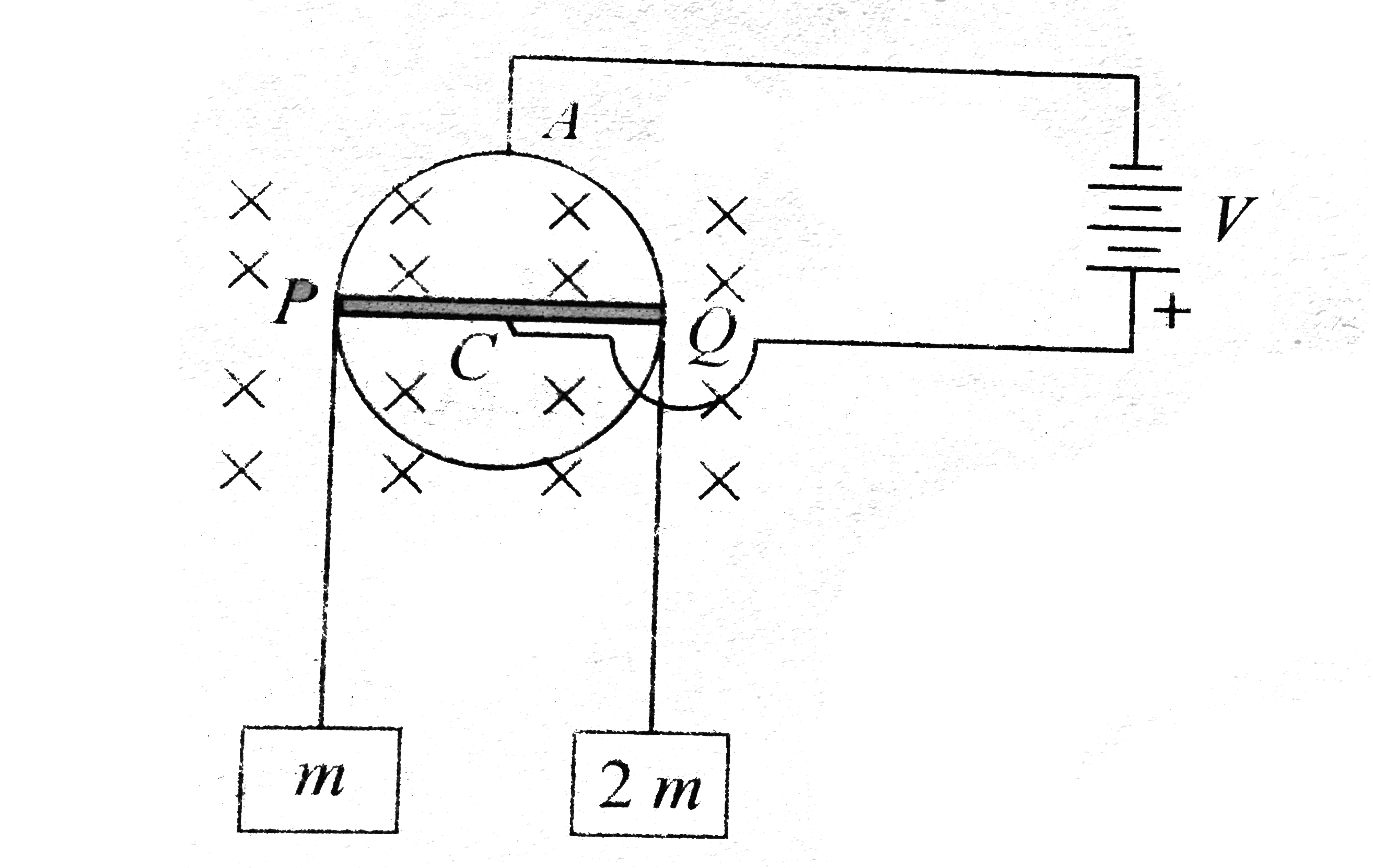
In static condition, find the current through rod PC.View SolutionA conducting bolloon of the radius a is charged to potential V0 and held at a large height above the earth ensures that charge distribution on the surface of the balloon remains unaffected by the presence of the earth. It is connected to the earth through a resistance R and a value in the balloon is opened . The gas inside the balloon escapes from value and the size of the balloon decreases. The rate of decrease in radius of the balloon is controlled in such a manner that potential of the balloon remains constant. Assume the electric permittivity of the surrounding air equals to that of free space (ε0) and charge cannot leak to the surrounding air.
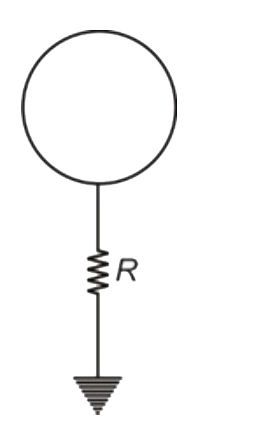
The rate at which radius r of the balloon changes with time is best represented by the equationView SolutionFree enegry , G=H−TS, is state function that indicates whther a reaction is spontaneous or non-spontaneous. If you think of TS as the part of the system's enegry that is disordered already, then (H−TS) is the part of the system's energy that is still ordered and therefore free to cause spontaneous change by becoming disordered.
Also, ΔG=ΔH−TΔS From the second law of thermodynamics, a reaction is spontaneous if ΔtotalS is positive, non-spontaneous if ΔtotalS is negative, and at equilibrium if Δ'→talS is zero.
Since, −TΔS=ΔG and since ΔG and ΔS have opposite sings, we can restate the thermodynamic criterion for the spontaneity of a reaction carried out a constant temperature and pressure.
IF ΔG<0, the reaction is spontaneous.
If ΔG>0, the reaction is non-spontaneous.
If ΔG=0, the reaction is at equilibrium.
Read the above paragraph carefully and answer the following questions based on the above comprehension.
A particular reaction has a negative value for the free energy change. Then at ordinary temperatureView SolutionPQRS is a square region of side 2a in the plane of paper. A uniform magnetic field B, directed perpendicular to the plane of paper and into its plane is confined within this square region. A square loop of side 'a' and made of a conducting wire of resistance R is moved at a constant velocity →v from left to right in the plane of paper as shown. Obviously, the square loop will enter the magnetic field at some time and then leave it after some time. During the motion of loop, whenever magnetic flux through it changes, emf will be induced resulting in induced current. Let the motion of the square loop be along x-axis and let us measure x coordinate of the centre of square loop from the centre of the square magnetic field region (taken as origin). Thus, x coordinate will be positive if the centre of square loop is to the right of the origin O (centre of magnetic field) and negative if centre is to the left.
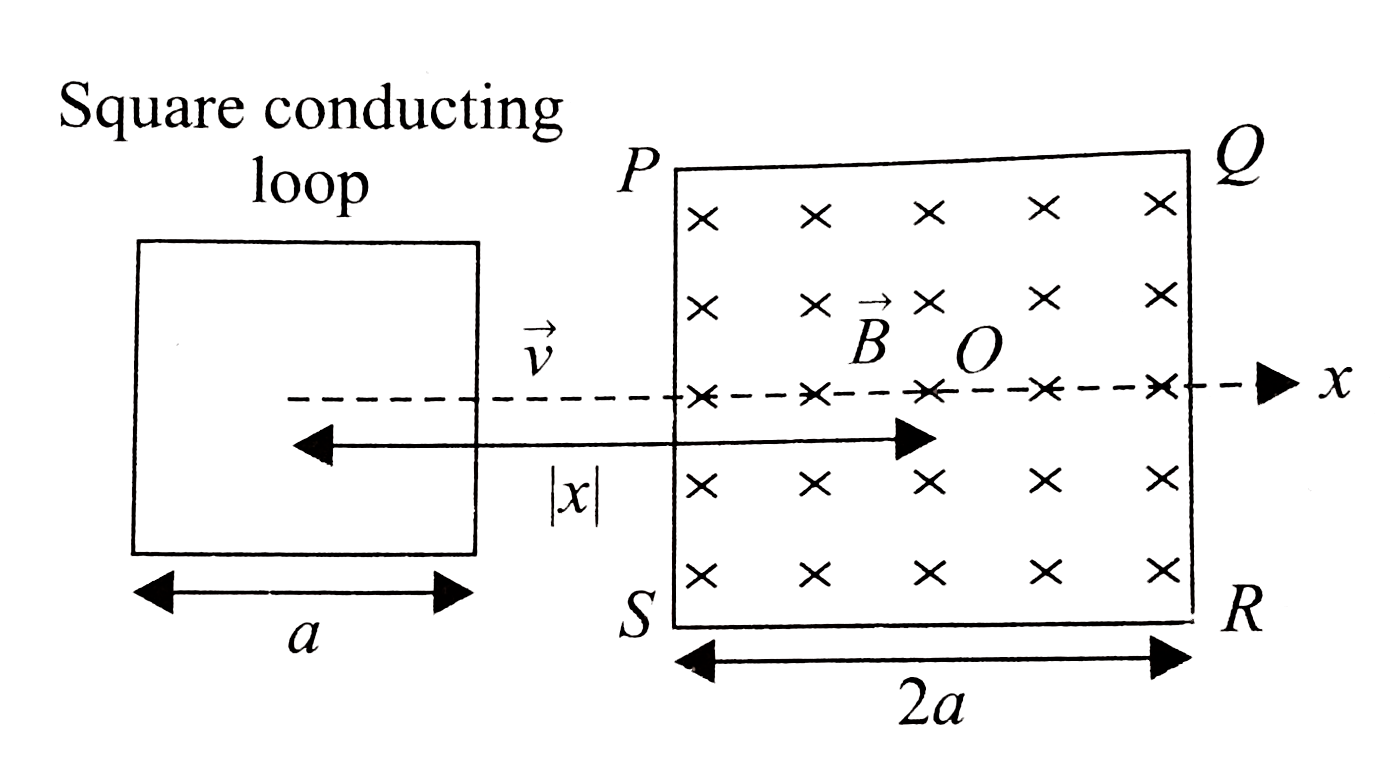
For x=a/4
(i) magnetic flux through the loop,
(ii) induced current in the loop and
(iii) external force required to maintain constant velocity of the loop, will beView SolutionPQRS is a square region of side 2a in the plane of paper. A uniform magnetic field B, directed perpendicular to the plane of paper and into its plane is confined within this square region. A square loop of side 'a' and made of a conducting wire of resistance R is moved at a constant velocity →v from left to right in the plane of paper as shown. Obviously, the square loop will enter the magnetic field at some time and then leave it after some time. During the motion of loop, whenever magnetic flux through it changes, emf will be induced resulting in induced current. Let the motion of the square loop be along x-axis and let us measure x coordinate of the centre of square loop from the centre of the square magnetic field region (taken as origin). Thus, x coordinate will be positive if the centre of square loop is to the right of the origin O (centre of magnetic field) and negative if centre is to the left.
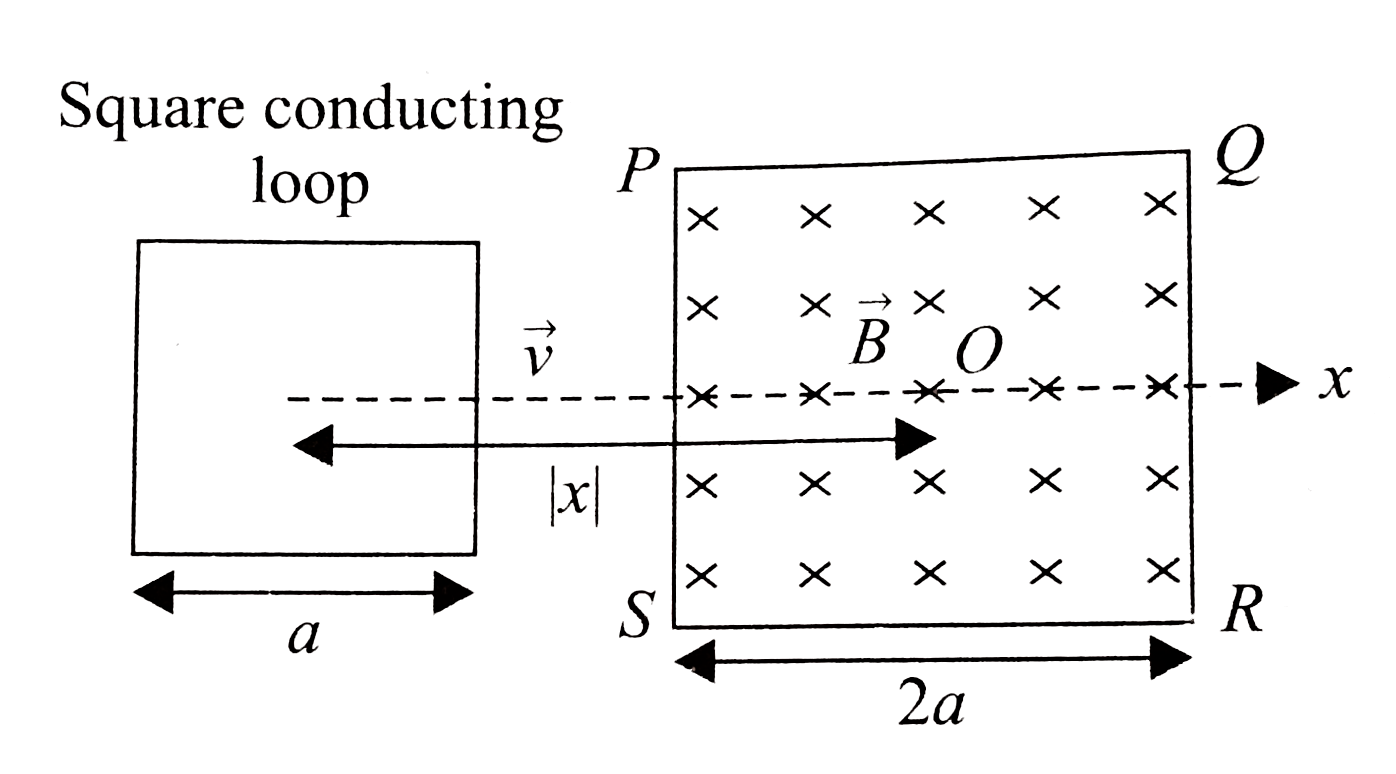
External force required to maintain constant velocity of the loop for x=−95a will beView SolutionPQRS is a square region of side 2a in the plane of paper. A uniform magnetic field B, directed perpendicular to the plane of paper and into its plane is confined within this square region. A square loop of side 'a' and made of a conducting wire of resistance R is moved at a constant velocity →v from left to right in the plane of paper as shown. Obviously, the square loop will enter the magnetic field at some time and then leave it after some time. During the motion of loop, whenever magnetic flux through it changes, emf will be induced resulting in induced current. Let the motion of the square loop be along x-axis and let us measure x coordinate of the centre of square loop from the centre of the square magnetic field region (taken as origin). Thus, x coordinate will be positive if the centre of square loop is to the right of the origin O (centre of magnetic field) and negative if centre is to the left.
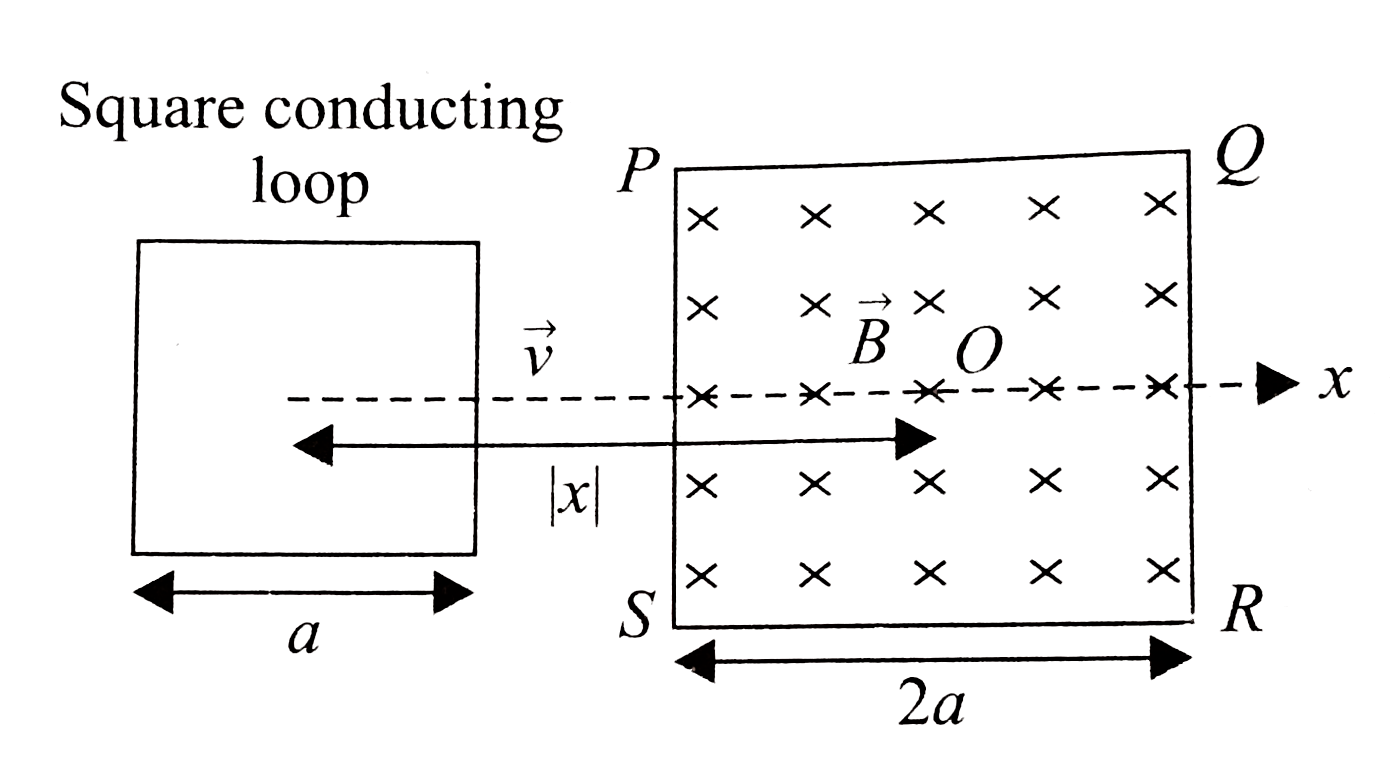
For x=−9a/5, magnitude of induced current and its direction as seen from above will be:View Solution

